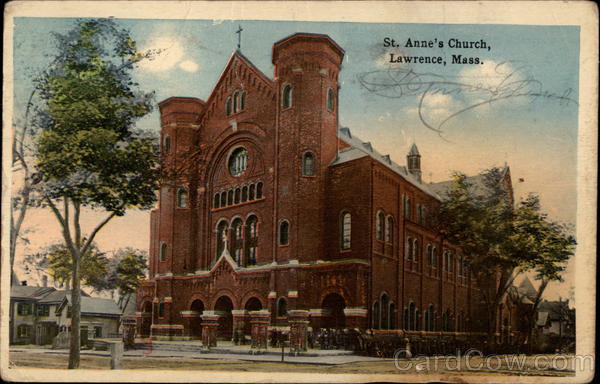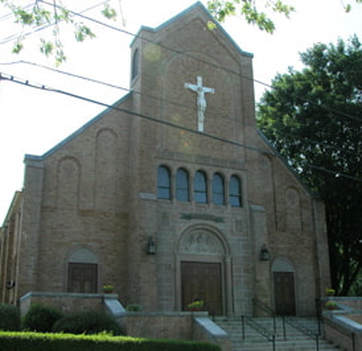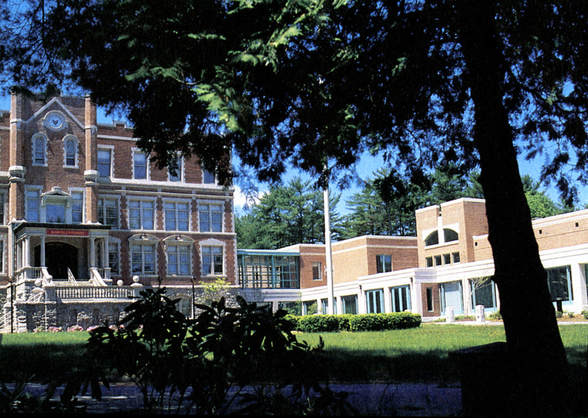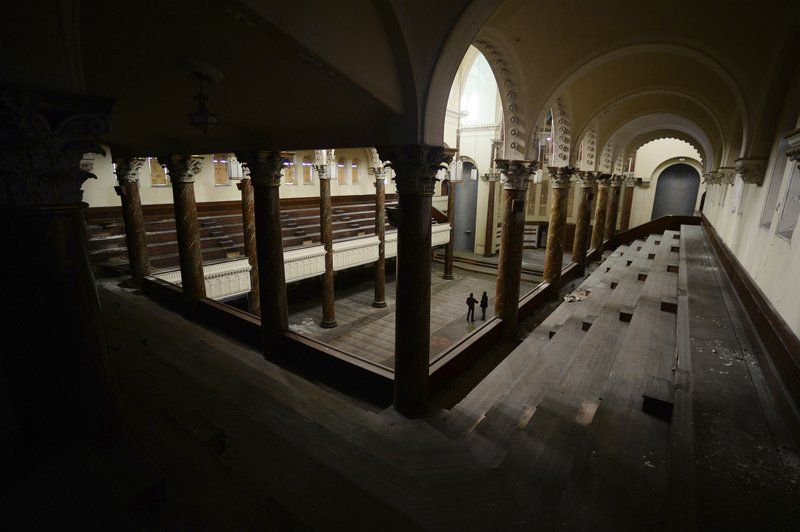St. Anne's Church, the Society of Mary (Marists) and the French Canadians of Greater Lawrence3/7/2018 Above: St. Anne's Church, Lawrence. Completed 1883, closed 1991 The French Canadians in Lawrence "Although less numerous in Lawrence than in Lowell, the French Canadians still contribute an important element to the Catholic population of this city." (from Byrne's History of the Catholic Church in New England, 1899) As described in another blog post, French Canadians began emigrating to manufacturing centers in New England after the Civil War. They brought with them a concept of La Survivance, an insistence on maintaining their French language and their culture, expressed to a large degree through their own Catholic institutions: French churches and French schools. The French-speaking Canadian immigrants were comprised of Québécois from the province of Quebec; and Acadians, the descendants of French-speaking settlers of New Brunswick and Nova Scotia (many of whom were forcibly moved to Louisiana after defeat by the British in 1755, where they became known as Cajuns). A French Parish One of the first things the French-speakers did in Lawrence was to create their own parish. This was no easy task. The Augustinian order was firmly in charge of the churches on the north side of the Merrimack River. So-called national parishes (foreign-language churches that catered to specific ethnic groups) in Lawrence were usually organized as mission churches of St. Mary's parish. St. Mary's was the main "cathedral", run by the Augustinian Fathers. Thus, the German-speaking Church of the Assumption, the Polish-speaking Holy Trinity Church, the Lithuanian-speaking St. Francis and the Portuguese-speaking Sts. Peter and Paul were all mission churches of St. Mary's, and were overseen by the (Irish-dominated) Augustinians. In contrast, through the importation of recognized French-speaking religious orders, the French were allowed to have their own independent parish in the Lawrence area. Eventually, St. Anne's parish grew to encompass four churches: St. Anne's, Sacred Heart in South Lawrence, Our Lady of Mount Carmel (Methuen) and St. Theresa (Methuen). All were essentially founded by the Marist Fathers, and in most cases were run by the Marists for decades, along with St. Joseph's in Haverhill, as further described below. The Marists come to New England The order was formally recognized by the Church in 1822. It was formed after a group of soon-to-be priests led by Jean-Claude Courveille and Jean-Claude Colin made a pilgrimage to the shrine of the Black Virgin at the cathedral of LePuy in France. There, they experienced healing while praying before the statue of the Virgin. They came to believe the Blessed Mother wanted to help the Church through a society consecrated to Mary and bearing her name. The Marists' first missionary work was in the remote areas of the Diocese of Belley in southeast France. The Marist order (not to be confused with the Marianist order), first focused their American mission in Louisiana, a bastion of French Catholicism, taking charge of St. Michael's in Convent, Louisiana in 1863 and overseeing two parishes and a high school. The fact that they arrived during the Civil War did not seem to dissuade them. Until 1880, the Marists were content mainly to operate in France; however, in that year, citing the principles of the French Revolution, the government of France ordered the closure of all Catholic religious orders in France. "With the expulsion of religious orders from France in 1880, the Marist General Administration sought new opportunities for their members in the United States. There were more opportunities than they could handle, but no more than in the New England states, where French-Canadians were pouring in to find employment in the mills that had sprouted up all over the area." (From the 150th Anniversary pamphlet of the Marist Order, www.societyofmaryusa.org/pdfs/Marist150YearsofGrace.pdf) The leadership of Rev. Elphage Godin, S.M. Like Rev. James O'Donnell, O.S.A. who brought the Augustinians to Lawrence, and Rev. Andre-Marie Garin, O.M.I., who led the expansion of the Oblates in Greater Lowell, Rev. Elphege Godin, S.M., was a larger-than-life figure. Above: Father Elphege Godin, S.M. (from the Society of Mary website) Born in 1847 at Trois-Rivieres, P.O., Canada, Father Godin was ordained in 1871 for the diocese of Trois-Rivieres (Quebec), where he served for several years. He joined the Society of Mary in France in 1878. (Source: Marist 150th anniversary pamphlet.) His first assignment as a Marist was to teach at Jefferson College in Convent, Louisiana, and to preach parish missions. Able to speak English as well as French, his services as a preacher were much in demand. In the early part of 1881, he was invited to preach in Old Town, Maine, and spent some time as a missionary in Waterville, Augusta, Biddeford and Brunswick, Maine, and also in Manchester and Lebanon, N.H. In May of that year, Father Olivier Boucher, the pastor of St. Anne’s in Lawrence, MA asked his assistance. (ibid.) Completion of St. Anne's Church "In 1869 there were only four hundred French Canadians in Lawrence. They were given religious instruction in their own language in the basement of the Immaculate Conception church. [Note: the so-called "basement church" for ethnic immigrants is still a practice today in the Catholic Church.] Knowledge of the success achieved by the French Oblates in Lowell reached them, and a movement was begun which resulted in a visit from [the Lowell-based Oblate] Father Garin, and the holding of regular services in Essex Hall." "In 1882...Rev. Elphage Godin, the well-known Marist...entered upon his duties in this important centre of French Canadian colonization. Under his management the church was speedily finished and dedicated, the ceremony being performed by Archbishop Williams on Low Sunday, 1883." (from Byrne's history of the Catholic Church in New England, 1899) "It is generally agreed that St. Anne’s Parish in Lawrence was the ‘Mother Parish’ of all Marist-operated parishes in New England." (www.societyofmaryusa.org/about/history-northeast.html) St. Anne's was followed by the establishment of Marist-run missions that became four French-speaking parishes in the Greater Lawrence area: Sacred Heart (Marist-operated for 101 years), St. Joseph (85 years); and in Methuen, Our Lady of Mount Carmel (78 years) and St. Theresa (61 years).(Ibid) Below: A 2015 picture of Sacred Heart Church, South Lawrence. Source: Wikipedia The Marist Fathers provide additional French-focused churches in the area Sacred Heart An 1899 history of the Catholic Church in New England noted that St. Anne's church was bursting to the gills with worshipers. This problem was remedied with the construction of Sacred Heart in South Lawrence, which eventually became a grand complex. The first church on the site was built in 1905, apparently being replaced by the current church starting in 1916. "The oldest building on the site is the 1899 school, a three-story, highly ornamental brick structure designed in the Romanesque Revival style. The convent, rectory, and second school were built in 1920, 1924, and 1925, respectively. The ground level of the church was constructed in 1916 as a one-story brick structure, but between 1934 and 1936, the original church was incorporated into a Gothic Revival-style building constructed of polychromatic ashlar." (Source: Sacred Heart Complex Approved for Nomination to the National Register of HistoricPlaces, https://www.sec.state.ma.us/mhc/mhcpdf/pressreleases/91911_Sacred_Heart_Complex_Lawrence.pdf) Sacred Heart was closed in 2005 and has since been taken over by a Catholic-inspired group not affiliated with the Catholic church, who hold Latin masses in the facility. St. Joseph's, Haverhill St. Joseph Church was founded in 1871. It was Marist-run from 1893 for eighty five years, when Father Godin became the superior, until 1978. "In the year 1870 the French Canadians of Haverhill were numerous enough to found a St. Jean Baptiste Society, whose president was soon deputed to visit Bishop Williams [in Boston] and request the services of a Canadian pastor. Through the efforts of Father Garin, of Lowell, an Oblate priest, Rev. Father Baudin, was sent to the town on Christmas Day, 1871. A hall on Water street had been fitted up as a chapel, and in that humble edifice Father Baudin held services and baptized two children. This was the foundation of the present flourishing parish of St. Joseph." (Source: Byrne's history of the Catholic Church in New England, 1899) A more imposing edifice was constructed in 1876. "The growth of the congregation, both by new arrivals from Canada and by local increase, compelled the erection of a church and at the same time made it financially possible. December 17, 1876, Archbishop Williams blessed the edifice which stands on the comer of Grand and Locust streets, and administered confirmation to nearly a hundred persons." (Ibid.) At some later date, the church on Bellevue Avenue was constructed, which stands to this day. Father Godin served for ten years at St. Joseph, firmly establishing the Marist presence, which continued under the tutelage of that Order until 1978. The French parish was closed in 1998, when St. Joseph merged with three other formerly ethnic parishes of the Mount Washington neighborhood: St. Michael (Polish), St. George (Lithuanian) and St. Rita (Italian). The combined new parish, All Saints, is housed in the former St. Joseph's building on Bellevue Avenue. The elementary school at St. Joseph's was the subject of a legal dispute when an anti-immigrant, pro-American Haverhill School Board ordered all schools to teach only in English in 1888. At the time, instruction was being given in French by Les Soeurs de la Charité d'Ottawa (Soeurs Grises de la Croix), the so-called Grey Nuns of the Cross from Ottawa. This incident will be covered in a separate blog entry, as will be the Grey Nuns, who had a prominent role in the Merrimack Valley including running the main hospital in Lowell for a century. St. Theresa’s (St-Thérèse) and Our Lady of Mt. Carmel (Notre-Dame du Mont Carmel), Methuen Above: St. Theresa, Methuen. From Our Lady of Good Counsel website Our Lady of Mt. Carmel was built in 1922 as the first French-Canadian church in Methuen, as a "mission church" of St. Anne's In the mid-1930s, the Marist Fathers established a second mission church, St. Theresa, to serve the growing French Canadian population there. Our Lady of Mt. Carmel closed in 2000. The ministry of St. Theresa's was eventually taken over by the Augustinians, and the church was merged with St. Augustine's in Lawrence (my church growing up) to form Our Lady of Good Counsel parish. They are apparently now under diocesan tutelage. The Novitiate in Tyngsboro, Mass. In 1922, the Marists purchased a portion of Wonalancet Farm in Tyngsboro, a suburb of Lowell. You may remember from other blog posts that this is where the hapless Wonalancet, sachem of the Pennacook Indians, lived out his days under the watchful eye of Captain Tyng following King's Philips War of the mid 1670s. They initially used the historic Tyng house, pictured below (which burned down in 1981) before building a more modern set of structures. Below: The historic Jonathan Tyng house, built circa 1675, burned down 1981 Above: The Marist novitiate (for training new members of the Order), late 1960s (source http://academic2.marist.edu/foy/maristsall/essays/innovation_academy.html) After World War 2, the Marist Order decided to establish a college in the United States, and the location was either going to be in Poughkeepsie, New York, where they had a large Novitiate, or in Tyngsboro at this site. Marist College was ultimately established in Poughkeepsie. If it had been established in Tyngsboro it no doubt would have been a rival of Merrimack College, the Augustinian college in North Andover. In 1979, following a significant decline in new members to the order, the Marists sold the Tyngsboro property to Wang Laboratories, who used it for their Wang Institute until 1988, when it was sold to Boston University as a corporate campus. In 1996, a charter school, Innovation Academy, began operating on the property and they apparently bought the land outright in 2008. Legacy of Father Godin "Father Godin was a Marist pioneer who planted the seed, nurtured and cared for it while it grew and, by the time he took leave of this earth, saw it firmly established. When he began at St. Anne’s in Lawrence, MA, in 1882, this was the only house the Marists had in the whole northeastern section of the country. When he died, 51 years later, in 1931, besides St. Anne’s the province included Our Lady of Victories, Boston, MA; St. Bruno’s, Van Buren, ME, St. Mary’s High School, Van Buren, ME, St. Mary’s College, Van Buren, ME (1887 to 1926), St. Joseph’s, Haverhill, MA, Our Lady of Pity, Cambridge, MA, Sacred Heart, Lawrence, MA; Immaculate Conception, Westerly, RI, St. John the Baptist in Brunswick, ME, St. Charles Borromeo in Providence, RI, St. Remi’s, Keegan, ME, a novitiate on Staten Island, NY, and two minor seminaries: one in Bedford, MA and one in Sillery, P.Q. Canada." Sadly, the time of his death marked the beginning of a long decline of the French-speaking churches of the Marists, most of which have since closed as a result of significant postwar demographic changes. A remaining institution of prominence is the Lourdes Center in Boston. "In Kenmore Square, the Marist-run National Lourdes Bureau of America, founded in 1950 by the Marists at the request of Archbishop Richard Cardinal Cushing, and through arrangement with the Bishop of Lourdes, France, mails out an average of 22,000 small bottles of Lourdes water every month. The ministry also publishes a bi-monthly newsletter to 47,000 readers, sponsors annual pilgrimages to Lourdes, and conducts daily Mass and confessions for students, residents, hotel workers and guests, as well as shoppers and visitors to the Kenmore Square area." (Source: Boston Pilot article, February 20, 2015) Below: 1950 Banquet to celebrate the cherished Marist Fathers of St. Anne's School, held in the gym at Central Catholic High School. Source: Lawrence History Center The Marist Brothers and Education The educational legacy of the Marists in Greater Lawrence is as important as their ecclesiastical legacy. Unlike some of the other religious orders, the Marists were strongly represented by brothers, who had taken vows but were not ordained priests. The Marist brothers were typically educators at the primary and secondary level. The educational attainments in the Merrimack Valley of the Marist Brothers will be covered in a separate blog entry. Their crowning legacy was probably Central Catholic High School, which was essentially spun off of the St. Anne's School of Lawrence by Brother Mary Florentius in 1935. Below: Central Catholic High School, Lawrence. It is still a Marist institution.  Other French-Canadian Institutions in Lawrence The Société Saint-Jean-Baptiste was once to the Franco-American community what the Knights of Columbus was to the Italians or the Hibernians was to the Irish. The Social Naturalization Club was founded in 1915. Located on Lowell Street in Lawrence, it hosted prominent political leaders, like Rose Kennedy in 1962 and Mrs. Joseph P. Kennedy in 1985. Later it was located at 120 Broadway. The LaSalle Social Club on Andover Street in Lawrence was another prominent Franco-American social institution. The community also had a French paper of their own, Le Progres. [Please help me add to this list.] Above: the interior of St. Anne's church, Lawrence, 2016. It has basically been abandoned and neglected since it closed in 1991. Source photo: Eagle-Tribune
14 Comments
Pauline Tremblay Caffrey
3/8/2018 11:03:50 am
Thank you! For sharing. I was Baptized in St Anne's. And married in St Theresa's.. I am very much interested in the history of the area, as my parents were immigrants of Quebec to work in the mills.
Reply
Carl Benedict McCarthy
3/8/2018 01:00:18 pm
You're welcome
Reply
M. Irene Rheaume Weber
3/8/2018 09:32:00 pm
My father was raised in Sacred Heart Parish, my mother was baptized in Ste Anne's parish and they were married in Ste Anne's. My mother sang in the choir. I was baptized in Sacred Heart Parish, but raised in Ste Anne's Parish. I also played the organ as a substitute organist while in high school, and was a member of the choir there. I was married in St. Theresa's Church. Thank you for your research. I remember the marching band that Ste. Anne's Parish had during WWII when they would practice in Ste. Anne's school yard.
Reply
Carl McCarthy
3/9/2018 07:11:44 am
Thank you for your commebt
Reply
Rita Payeur Motto
6/5/2024 09:18:35 pm
The drum corps name was the St Anne Crusaders. O knew them well. I sent several pictures to the Lawrence library. My father was involved with them.. My brother was a drummer.
Reply
Ann Marie Bourque
2/15/2019 10:05:41 pm
Hello everyone, I was wondering if anyone knows any of the companies that built St. Anne's Parish Church in Lawrence, MA? I came across a small note in my parents paper work that Ernest Bourque and or Bourque Construction helped built it, It is only a small, one line comment.. and I have not been able to find anything else... Thank you for any help in this ...
Reply
3/2/2019 01:11:56 pm
Thank you for your research and blog. I grew up in Ste Anne Parish as did my mother. My Levesque great grandparents were among the founders of the parish. I have been told that my grandfather Etienne Levesque was the one, who with his brother, installed the beautiful weather vane that once adorned the top of the church. Now.. I would like to offer one correction regarding the Acadians: they were never sent to Louisiana in 1755 by the British. At the time it was a possession of France. The Acadians did not go to Louisiana until 1764 after the Treaty of Paris was signed in 1763..
Reply
James J. Ouellette
6/7/2019 10:59:26 am
The picture of the church was wrongly identified. It is St. Joseph, now All Saints in Haverhill.
Reply
Harry
5/22/2020 08:33:19 pm
It is indeed Ste. Anne's church in Lawrence, MA.
Reply
Lucie LeBlanc-Consentino
6/7/2019 01:45:29 pm
Sorry James but you are mistaken. The first photo posted is that of a post card showing Ste Anne's Church in Lawrence, MA.
Reply
Denise (Becotte) Back
6/24/2019 11:05:05 am
I’m sorry Lucie, but I too agree with James Ouellette, this is not the St. Anne’s I remember.
Reply
Lucie LeBlanc Consentino
6/24/2019 12:58:02 pm
Sorry Denise but I disagree. I grew up in Ste Anne's - the very first post card printed at the top of this block is definitely Ste-Anne's Church. There used to be a little chapel across the street that was converted into two parish halls instead of one. My great grandparents were among the founders of Ste Anne's Parish on Haverhill Street in Lawrence. I went to Ste Anne's grade school which was called St. Joseph's when I was a kid and Ste Anne's was then the boys school staffed by Marist Brothers. I graduated from St. Joseph/Ste Anne High School in 1954.
Jim Beauchesne
2/2/2024 08:17:31 pm
Bonjour mes amis! i too grew up in St. Anne's and attended St. Anne's grammar school, 1962-1970. I've also studied the parish history and French-Canadian history in grad school, and worked at Lawrence Heritage State Park for many years. I believe the church photos above are identified correctly. St. Anne's "parish hall", across Haverhill Street, was the original St. Anne's Church, completed in the 1880s and seating 1100. By 1903 they had outgrown it and built the St. Anne's church we know, which was completed in 1906.... seating about 2300!
Reply
Carl McCarthy
2/3/2024 03:16:36 pm
Dear Professor Beauchesne,
Reply
Leave a Reply. |
|








 RSS Feed
RSS Feed